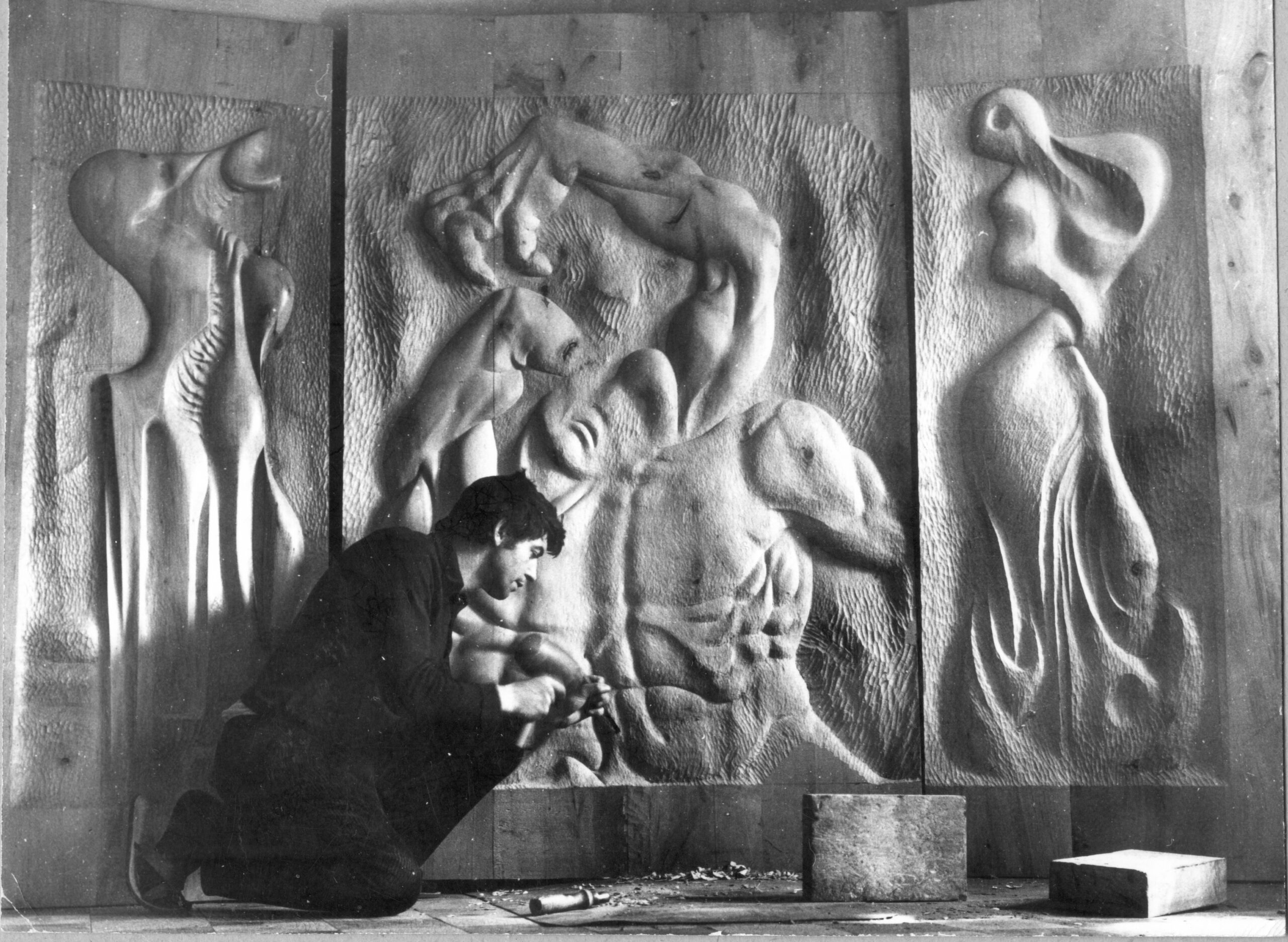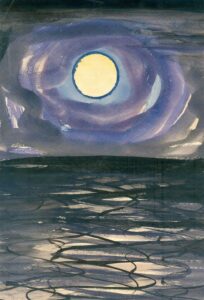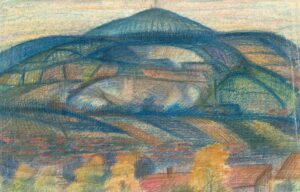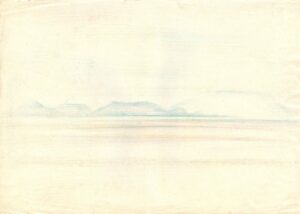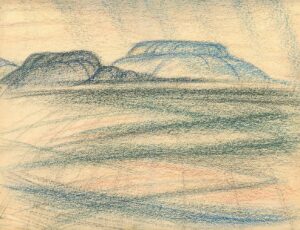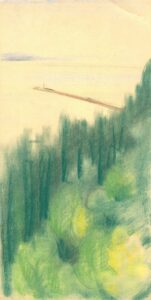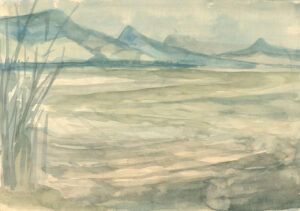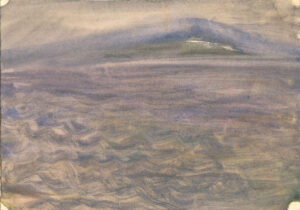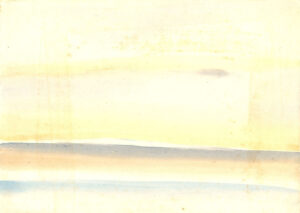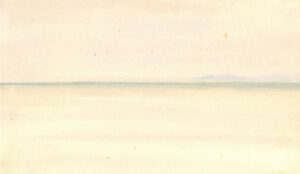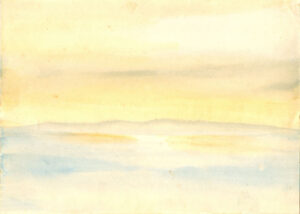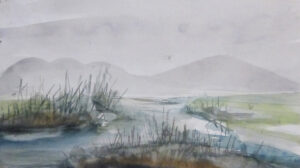It may sound strange to mention graphic design in connection with Gyula Bocz because he is known as a sculptor from Baranya who worked mostly in Pécs, Hosszúhetény and Nagyharsány. Though Bocz’s basic material is stone and he made relatively few sculptures and reliefs with wood and metal, drawing played an important role in his work for more than four decades for him to preserve impressions, designs and compositions. As one of the founders of Hungarian land art in the late 1960s, Bocz produced a significant amount of visual art that is not well known and has not been written about by art historians. In his sculptural works, the subtle yet elemental relationship between the material, the unfoldable form and the mind is very important, as this is revealed in Bocz’s techniques and graphic designs.
His passion for stone carving also led to a significant number of two-dimensional works. The hundreds of his prints show a considerable amount of drawing activity. Bocz intended most of these as studies for his sculptures, using them to record his impressions and rehearse his compositions. What they have in common is the sculptor’s unconcealed infatuation with his craft. They also illustrate the imminent, idiosyncratic dimension in which amazement and play are linked to reality and the limits of its visibility. These prints are sincere reflections on a “panorama” of nature and humanity that can be transformed and recreated by the changes of air, wind and light. The spirit of this environment shaped by the artist reveals both awe and exceptional attention. At the same time, this attention also reflects the sober alertness of an inspired artist with an original vision, who is steadfast in his own primordial form while seeking out and showing us the lines between the accessibility of the living and the dead through his own sensitivity.
His drawings can be divided into three main groups: the first group primarily includes portraits made in the second half of the 1950s at the Pécs Free School of Fine Arts, led by Ferenc Martyn (1899-1986) and Ferenc Lantos (1929-2014), who were also committed to art education; the second group consists of drawings of landscapes and travel, which he made during his travels abroad and in Hungary, such as the Gdansk cityscapes from his 1964 trip to the North Sea; the third group is comprised of sculptural designs. Bocz regularly made detailed preparatory draft drawings of his sculptures. A common feature of these drawings is that they are unsigned, undated and untitled. Technically they are mainly watercolour, crayon or ink drawings.
The travel drawings include images on the theme of Lake Balaton, and he applied a watercolour and crayon technique to make theses in the 1960s. Recognisable motifs are the mountains of the western basin on the north coast of Lake Balaton – Abraham Hill, Badacsony, Szigliget, Becehegy, Gulács, and Szent György Hill – and the reed beds of the south coast. The dramatic mountain landscapes and the deep, dark lake bathed in light depicted with stormy waves were the subject of some thirty drawings. With few exceptions, Bocz’s compositions are in landscape format. The horizon is usually placed in the middle, but in one instance there is a view of the lake from the top of a mountain with a low horizon. Man-made buildings or piers appear as integral parts of the landscape in only two of the paintings. These landscape studies focus on the lake and the water as constantly changing elements including the shore, light phenomena (reflections, shadows), waves and vegetation on the shore.
In most of Bocz’s Balaton drawings the surface of the lake is bathed in light with a subtle, pale colouring, while in three of the prints the stormy and frozen waters of winter are shown in greyish tones. In all cases, the overall picture is defined by the relationship between water and air, shaped and influenced by light. In about half of the images, the shapes of the northern mountains take centre stage, while in the others the coastline is almost dissolved in the light.
Water is the subject of several of Bocz’s sculptures. Following a trip to Poland in 1964, he created several (at least four) sculptures entitled Sea in black marble from Kantavár. His other water-related works are the Stars near the marketplace in Pécs (1973) and the Family – Palm Stone of Giants (1993), which is currently a fountain in the main square of Komló. There are apparently few formal similarities between Bocz’s Balaton-themed drawings and his water-related sculptures. While his drawings and paintings relied on the construction of large landscape contours through colour, these almost disappear in the sculptures, where water droplets (Stars) and waves (Family – Palm Stone of Giants) dominate. Synchronizing with all these elements, the world of the Balaton drawings is nevertheless perceptible in the background of the monumental sculptures. The almost infinitely extended landscape depiction of Lake Balaton is a kind of self-contained sculptural cross-section of the natural environment – a confession and creed with lines and forms; gentle, yet definite and conscious depictions, sculptural sketches, parts of future sculptures.
It is obvious that he was strongly influenced and sometimes captivated by the theme of Lake Balaton, experimenting with various techniques, both natural and abstract. The drawings were probably made at different times, but mostly in the 1960s, and they can be regarded as sketches. They are at the same time traces of attempts and experiences, witnesses to so far unknown sculptural vision – anonymously hidden in the legacy, with characteristically ‘Boczian’ traits.
Written and edited by: Anna Tüskés
